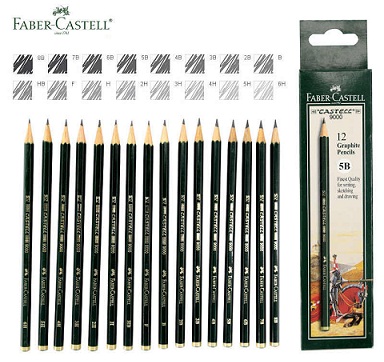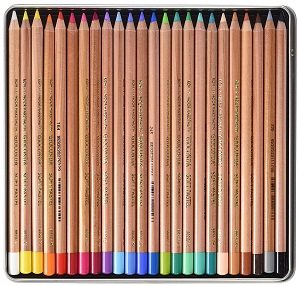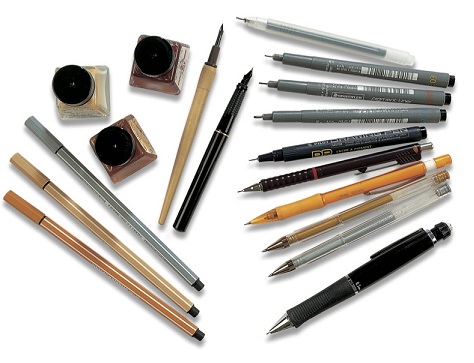Products You May Like
The materials expected to start drawing are straightforward: a device to leave an imprint and a piece of paper on which to make it. Pencils and paper are the beginning materials for the vast majority.
As you develop as a craftsman, you will soon find that you need to evaluate various procedures and new materials. Despite numerous innovative advances, craftsmen’s materials have changed minimally throughout the long term.
Most materials are simpler to utilize, and there is a more extensive scope of colours accessible. Yet, how we use them remains unaltered.
Luckily, most drawing materials are somewhat economical and equipped to deliver numerous drawings before they are supplanted.
It is prescribed that to stay away from high cost and frustration, purchase tolerably from the get-go. Start with a medium that requests you and stage in others slowly as you want to widen your reach and revive your methodology.
Graphite pencils

They are reviewed from hard (H) to delicate (B). 9H is the hardest though 9B is the gentlest, with F (OK) and HB in the center reach.
H pencils (2H, 3H, and 4K; they continuously become more enthusiastically) are helpful for noticeable light lines yet will scratch into the outer layer of your paper, so B pencils are better for gentler, apparent work.
Each pencil grade will create a tone of given dimness, and no measure of strain will make that tone hazier.
If you require a hazier tone, you should change to a gentler grade of pencil. Soft pencils will give a more prominent scope of techniques than hard pencils and can be eradicated without leaving an indent should you commit an error. It is consequently that most drawings are made utilizing a pencil which is HB or milder.
Intend to utilize a 2B or 3B to begin your attracting and change to a gentler—or more black—pencil, like a 6B or a 9B, for more deep tones.
Most mechanical pencils, otherwise called grip or moving pencils, are helpful for accuracy work, yet the gentlest grades are difficult to track down.
Pastel pencils

These pencils are more diligently than soft pastels and look like shaded pencils, even with a scratchier, chalkier feel. They are helpful for actual line work, just as concealing, as they are non-waxy and can be mixed well.
The imprint made with a pastel pencil isn’t long-lasting and should be showered with a fixative (see more on fixatives beneath). These pencils are extremely simple to work with.
There is a wide assortment of solid tones accessible. They are excellent for completed drawings and fast outlines and are particularly powerful when utilized on shaded paper.
Colored pencils

These are accessible in various shadings and structures, like the norm, water-solvent, and excellent and lousy led, and they change in quality and non-abrasiveness. In contrast to pastel pencils, shaded pencils shouldn’t be showered with a fixative.
Some hued pencils make sharp, distinct lines, while others are gentler and can be mixed all the more without any problem.
Layering shadings will deliver various shades, and sudden outcomes can be accomplished by utilizing a similar gathering of tones in different arrangements, so it merits testing to discover the best request for a specific shade.
Conté Sticks, crayons, and pencils

The most well-known shadings are earth tones—white, dark, greys, tans, and rusts, like hopeful (a ruddy brown) and sepia—however, they are additionally accessible in a broad scope of different tones.
They function admirably on hued paper and can be utilized with other dry drawing media. While the pencils are more reasonable for line work, the sticks can hinder in bigger spaces of tone. They can be smeared and mixed yet are not effectively deleted.
A broad scope of conté pencils is accessible in the conventional shades of dark, white, sepia, optimistic, earthenware, and bistre (a greyish brown).
Specialists’ pencils take after customary graphite pencils but at the same time are accessible with a rectangular profile.
A portion of the pencils has a wax content that empowers them to be utilized without fixing; however, different pencils are chalkier and require fixative security.
Charcoal sticks and pencils

(Extra-thick posts are otherwise called “scene painters’ charcoal.”) Thin sticks function admirably for hiding, feathers, and other fine detail, while block charcoal performs admirably for huge regions.
Packed charcoal, otherwise called Siberian charcoal, is made into a pencil with wooden or moved paper barrels and is cleaner than traditional stick charcoal.
It is evaluated by hardness and thickness and can be found with both round and square profiles. They produce hazier, more sharp lines, which are hard to smirch or mix.
Hone all charcoal by utilizing a sharp utility blade or by using fine-grade sandpaper. Charcoal residue sits gently on the help surface and will require fixing to try not to be besmirched.
Graphite sticks

The barrel shape is round for certain brands covered with a thin layer of plastic paint eliminated as the stick is utilized, which helps keep the fingers clean.
The state of the stick implies that as the bar is honed, a vast space of graphite is constantly uncovered.
This makes it conceivable to create not just scarcely discernible differences—which can be made into exceptionally thick lines by adjusting the point at which the stick comes into contact with the help—yet additionally wide spaces of level tone. Like pencils, they help portray and mix.
More limited, thicker, hexagonal sticks are likewise accessible in a comparative scope of grades, as are more modest rectangular squares.
The two kinds of posts are best honed utilizing a pencil sharpener or with fine-grade sandpaper. The subsequent powder can be scoured onto drawings to make spaces of tone. More significant amounts of residue can be bought from craftsmanship stores.
Similarly, as with customary pencils, barrels that work with a grasp system can be discovered that hold thicker, gentler grade graphite strips. When utilizing skinny, meagre graphite sticks, take Care when squeezing hard as it snaps without any problem.
White chalk

Pens

Wellspring or cartridge pens, roller-ball, ballpoint, fine liners, and expert craftsmanship pens accompany a broad scope of nibs and can be utilized for fast portrays and more nitty-gritty drawings.
Ballpoint pens can be smooth and fulfilling to utilize and help portray. Everything pens can make fine, streaming lines with soft and unpretentious outcomes.
Even though there are so many pen types, most have a similar downside—the size or width of the line from a pen is fixed. It is significant when utilizing these pens to analyze to discover what is or alternately is absurd.
The pens convey direct stamps, and tone is just accomplished through some incubating or cross-bring forth. A few cells utilize water-solvent inks, making it conceivable to pull out the style from the line work by using water.
Pens that utilization water-solvent inks are particularly valuable as it is feasible to reset regions to ease up the line work and pull out spaces of tone.
Brushes and dip pens

Plunge pens are pen-holders with exchangeable, adaptable metal nibs. Specific nibs just fit certain pen barrels, so attempt before you purchase.
Sometimes, you may track down that another nib is hesitant to hold ink, yet scouring a little spit onto the bill can settle this. Pointed beaks help draw the figure, albeit square, etched, and adjusted nibs would all be able to deliver intriguing outcomes.
Options in contrast to the steel nib are the conventional plume, bamboo pen, and reed pen. Plume pens produced using goose feathers are a joy to utilize and give a brilliantly sharp and expressive line (however, they should be occasionally re-cut).
Pens cut from a length of bamboo will differ in size and thickness; they are tough and ideal for textural work.
Reed pens are comparable, yet the cut nib is fragile and will generally break; in any case, they are effectively re-cut utilizing a sharp art blade.
Ink

The two inks can be mixed with water to make tones, yet while waterproof ink will dry fixed, water-dissolvable ink can be rewetted and yet again worked. Water-solvent inks empower the craftsman to relax line work.
Maybe the most popular ink is Indian ink. This dark ink is truth be told from China and turns into a warm, profound sepia shading when weakened with water. It’s waterproof and dries quickly.
Sharpeners

They permit you to grind the mark of your medium to suit the kind of work you are doing—like long, short, or calculated. They are likewise incredible for managing messy edges from erasers.
Pencil sharpeners make a perfect point and are best for graphite sticks. However, it would help if you guaranteed that the cutting edge is in every case sharp before use.
Fine sandpaper blocks are likewise an excellent choice for keeping the focuses on graphite sticks in great request.
Erasers and stumps

They can be molded to eradicate exact regions and for “lifting out” features in apparent substantial areas.
A detriment to utilizing clay erasers is that they get grimy immediately when used with charcoal, delicate graphite, or carré sticks.
More rigid plastic or vinyl erasers get less color and stay cleaner. They can be utilized on their edge to make new, etched lines in spaces of deep tone; on the other hand, they use sharp corners to create designs and depict the surface.
They likewise eliminate obstinate pencil or graphite imprints and minor blunders. Care should be taken when utilizing hard erasers not to trouble the help surface.
For mixing charcoal, chalks, and pastel pencils, you might need to utilize a paper stump called a torch-on or tortillon.
This item is used to control and mix free color, driving it into, and solidifying it on, the paper’s surface. As the stump becomes filthy, it tends to be cleaned by scouring it with fine sandpaper.
Fixative

When showered onto a picture, the soul dissolvable vanishes and a meagre covering of gum is abandoned, which ties the shade residue to the help.
When fixed, even an eraser can’t modify a drawing. It is conceivable, be that as it may, to deal with the top of a good picture, and it is generally expected practice to fix a drawing intermittently while it is being made.
Fixative is best applied to utilize a without CFC spray, adhering to the producer’s guidelines. Containers with a hand-worked shower and a mouth-splash diffuser are additionally accessible.
Papers and supports

Harsh is, as the name recommends, a paper with a hollowed profoundly finished surface. It is most appropriate for bolder, expressive work utilizing charcoal, chalks, pastel pencils, and delicate graphite.
Papers with an exceptionally smooth surface are known as “hot-squeezed” because the drying sheet of the mash is gone through hot steel rollers when being made.
These papers are most appropriate to pen and ink work, wash drawings, and fine pencil work and are less agreeable when utilized with delicately pigmented drawing apparatuses like charcoal and chalk. This is because the color dust needs a finished surface to stick to.
Papers with a medium finished surface are known as “cold-squeezed” or “NOT” (which means not hot squeezed). Papers in this gathering function admirably with most drawing materials and are maybe the most generally utilized sorts of paper.
Top-notch paper, generally named “corrosive free,” is killed to neutralize corrosiveness and won’t become brown or weak.
Cartridge (standard drawing) paper is the kind of paper frequently utilized for illustration. It very well may be white, cream, or hued and
Is accessible in different loads, sizes, and characteristics. Water colour paper is accessible in other loads and is helpful for a wide range of drawings.
Pastel paper arrives in various colors and has a “tooth” or grain intended to catch and hold the minuscule shading particles.
One side of the article is generally finished, which is the side many people draw on. However, you can utilize the opposite side if you like.
Pastel paper comes in two loads; thicker paper can take heavier scouring and revamp than lighter paper.
Paper can be bought as free, single sheets, or in sketchbooks and cushions. Single sheets empower you to evaluate a few different papers and can be sliced or torn to measure.
When drawing structures on the spot, be that as it may, you will discover utilizing a sketchbook significant.
They are made with paper of different surfaces, shadings, and loads and come in many sizes and ties in both representation and scene designs.
Pocket-sized books can be conveyed anyplace, however, perhaps prohibitive when you’re handling more prominent subjects.
Enormous sketchbooks are tiring to hold yet offer versatile space, alternatively making a few investigations on one page.
Drawing boards and easel

Maybe use attracting pins to tie down the paper to the board and put resources into several spring-stacked board cuts.
You can purchase a reason made planning phase from a decent craftsmanship shop or utilize a sheet of pressed wood or MDF (medium-thickness fiberboard).
On the off chance that utilizing sketchbooks or paper got to a board, it isn’t essential to have an easel. In any case, if you end up working a great deal in areas where it is hard to track down someplace on which to rest on board, you might think that it is favorable to put resources into a versatile drawing easel.
Easels come in many sizes, so pick one that you can sit or stand serenely. A few easels overlap away into a drawing case. The main thought here is strength.
An easel should be sufficiently able to hold your planning phase and take the tension and weight you apply as you work. A viable decision is a flexible table easel or a lightweight portraying easel.
